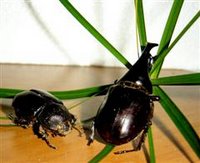Rhino beetles
Rhino beetles aren’t easy to find (in the Philippines at least), but certainly worth the search. First of all, did you know they can hiss? I only found out the first time I picked up my male. I got both my beetles from my biology teacher, who is actually an entomologist. They were already fully grown so I had no way of knowing how old they were. However, the female survived for five months in my care and the male a couple of weeks longer. They might not live very long, but rhino beetles make worth-while pets.
Difficulties: While you can handle these pets without much danger to the handler (although, be warned, if they clasp their vice-like legs around your finger they can be rather hard to remove… and they do have spikes on their legs). However, persistent handling can stress them.
Rewards: Low maintenance, fascinating pets that make “unconventional” an understatement. Plus, just look at those awesome photos!

Housing: Doesn’t really matter. OK, if you have females you will need something that can be covered and has soil for her to dig in, especially if you want to breed them. Otherwise, I used to keep mine in a small aquarium with about four inches of soil, a small pot plant, two pebbles, a tap with water (for humidity more than anything else), a small piece of wood for them to ‘explore’ and a food container. The pebbles are extra, but they made the aquarium look a bit nicer. Be aware that they make a mess when they eat – they mush their food into a pulp and the female tended to bury it – so I’d suggest you place it on a piece of plastic. Otherwise waste food might rot, which can kill most small pets (probably including beetles). Oh, only house one male per aquarium and don’t place them in direct sunlight.
Breeding: Sexing rhino beetles is dead easy. The male has horn-like projections, i.e. the long thing protruding from their forehead (look at the photo and understand what I am trying to say). Breeding these guys requires lots of patience… I didn’t actually do it myself, but there is a significant amount of info on the web. The instructions at http://www.harink.com/~benjamin/dhhbreeding.htm are a decent guide.
Feeding: I fed mine purely fresh fruits, mostly papaya and Mango. Generally I’d just let them devour whatever my Philippine Hanging Parrot didn’t eat. As I mentioned in the Housing section, food should be placed in a plastic container that can be removed and washed. How much your beetles eat may vary. If they mush everything you give them, just give them a bit more… If the female is burrowing I suggest you remove the male, unless you’re keen on breeding. Otherwise try your best to makes sure the female gets a chance to eat (even though she won’t necessarily eat anything), but do not dig her out, even if you can see her through the side of the aquarium. You could very easily damage her (even though their exoskeleton is remarkably hard).
 Final words of advice: After a month or so I ended up separating my male and my female. I left the female in a separate container I hoped she would lay eggs in and kept the male in a nicely-decorated setup. He became rather tame – or simply too old to complain when handled, but I still recommend you only handle them when necessary (or when showing them to guests).
Final words of advice: After a month or so I ended up separating my male and my female. I left the female in a separate container I hoped she would lay eggs in and kept the male in a nicely-decorated setup. He became rather tame – or simply too old to complain when handled, but I still recommend you only handle them when necessary (or when showing them to guests).


0 Comments:
Post a Comment
<< Home